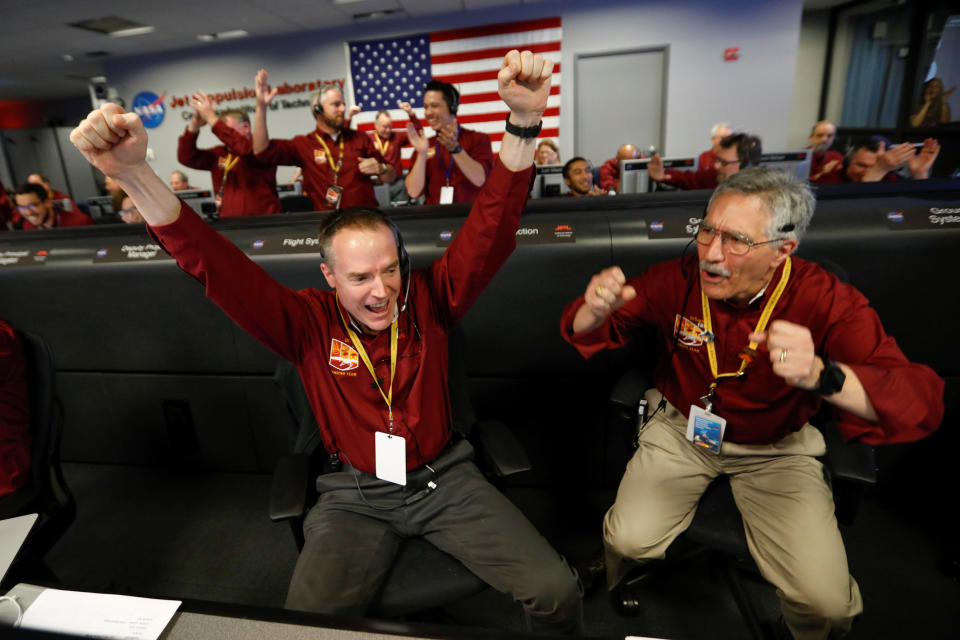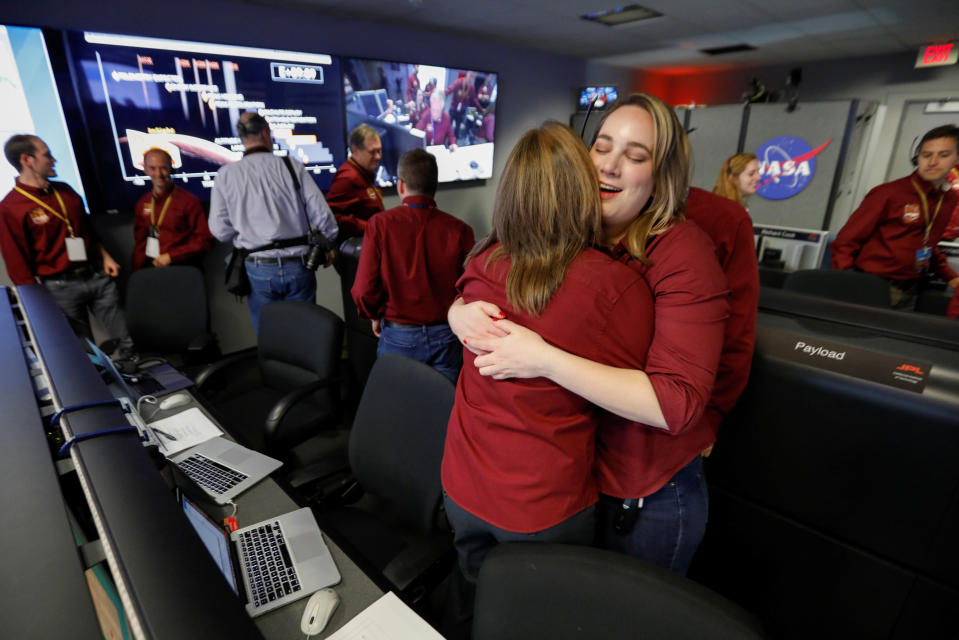NASA releases eerie photo after Mars landing following 'seven minutes of terror'
A NASA spacecraft designed to burrow beneath the surface of Mars landed on the red planet on Monday after a six-month, 482 million-kilometre journey and a perilous, seven-minute descent through the rose-hued atmosphere.
After waiting in white-knuckle suspense for confirmation to arrive from space, flight controllers at NASA’s Jet Propulsion Laboratory in Pasadena, California leaped out of their seats and erupted in screams, applause and laughter as the news came in that the three-legged InSight spacecraft had successfully touched down.
But it was the final “seven minutes of terror” that had NASA staff sitting on the edge of their seats.
“There’s a reason engineers call landing on Mars ‘seven minutes of terror’,” InSight landing team leader Rob Grover said.
“We can’t joystick the landing, so we have to rely on the commands we pre-program into the spacecraft. We’ve spent years testing our plans, learning from other Mars landings and studying all the conditions Mars can throw at us.”
📸 Wish you were here! @NASAInSight sent home its first photo after #MarsLanding:
InSight’s view is a flat, smooth expanse called Elysium Planitia, but its workspace is below the surface, where it will study Mars’ deep interior. pic.twitter.com/3EU70jXQJw
— NASA (@NASA) November 26, 2018
A pair of mini satellites trailing InSight since their May lift-off provided practically real-time updates of the spacecraft’s supersonic descent through the reddish skies. The satellite also shot back a quick photo from Mars’ surface.
The image was marred by specks of debris on the camera cover. But the quick look at the vista showed a flat surface with few if any rocks — just what scientists were hoping for. Much better pictures will arrive in the hours and days ahead.
Wild celebrations at NASA’s Pasadena lab
“What a relief, this is really fantastic…. wow, this never gets old,” Mr Manning said.
People hugged, shook hands, exchanged high-fives, pumped their fists, wiped away tears and danced in the aisles.
“Flawless, this is what we really hoped and imagined in our mind’s eye,” JPL’s chief engineer, Rob Manning declared.
“Sometimes things work out in your favour.”
InSight, a US $1 billion international venture, reached the surface after going from 19,800 kph to zero in six minutes flat, using a parachute and braking engines. Radio signals confirming the landing took more than eight minutes to cross the nearly 160 million km between Mars and Earth.


Viewings were held coast to coast at museums, planetariums and libraries, as well as New York’s Times Square.
NASA last landed on Mars in 2012 with the Curiosity rover.
“Landing on Mars is one of the hardest single jobs that people have to do in planetary exploration,” InSight’s lead scientist Bruce Banerdt said before Monday’s success. “It’s such a difficult thing, it’s such a dangerous thing that there’s always a fairly uncomfortably large chance that something could go wrong.”
Mars has been the graveyard for a multitude of space missions. Up to now, the success rate at the red planet was only 40 percent, counting every attempted flyby, orbital flight and landing by the US, Russia and other countries since 1960.
The US, however, has pulled off seven successful Mars landings in the past four decades, not counting InSight, with only one failed touchdown. No other country has managed to set and operate a spacecraft on the dusty surface.
InSight was shooting for Elysium Planitia, a plain near the Martian equator that the InSight team hopes is as flat as a parking lot in Kansas.

Digging five metres into Mars’ surface
The stationary 360kg lander will use its 1.8 metre robotic arm to place a mechanical mole and seismometer on the ground. The self-hammering mole will burrow 5 metres down to measure the planet’s internal heat, while the seismometer listens for possible quakes.
No landing craft has dug deeper on Mars than several inches, and no seismometer has ever worked on the planet.
Germany is in charge of InSight’s mole, while France is in charge of the seismometer.
An ecstatic Philippe Laudet, the French Space Agency’s project manager, said at JPL that now that the seismometer is on Mars, a “new adventure” is beginning.
By examining the interior of Mars, scientists hope to understand how our solar system’s rocky planets formed 4.5 billion years ago and why they turned out so different — Mars cold and dry, Venus and Mercury burning hot, and Earth hospitable to life.
InSight has no life-detecting capability, however. That will be left to future rovers, such as NASA’s Mars 2020 mission, which will collect rocks that will eventually be brought back to Earth and analysed for evidence of ancient life.


